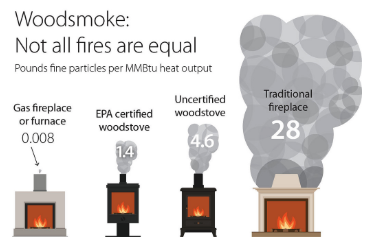Wood Burning

Health Impacts
Wood smoke may smell good, but it’s not good for you. The nostalgic smell of wood smoke comes from deadly compounds like benzene. If you smell wood smoke, you know you are being harmed. The small size of wood smoke particles (2.5 micrometers) make them seven times more likely to be inhaled into the body than other types of particles.

Heart Impacts: Wood smoke increases the risk of heart attack, irregular heartbeat, heart failure, stroke, irregular heart rhythms, and early death, especially in people who are already at risk for these conditions.

Lung Impacts: Wood smoke can trigger asthma attacks, damages children’s lungs, and can lead to emphysema, chronic bronchitis, and arteriosclerosis.
Watch this video for a better understanding of the danger of wood smoke.
Quick facts on wood smokes impact on human health
- There are over 200 dangerous chemicals and heavy metals in wood smoke, including dioxins, benzene, mercury and polycyclic aromatic hydrocarbons
- The EPA estimates that an equal amount of particulate pollution from wood smoke is 12 times as carcinogenic as an equal amount from second hand cigarette smoke
- Burning 10 lbs. of wood for one hour, releases as much PAHs (polycyclic aromatic hydrocarbons) as 6,000 packs of cigarettes
- Toxic free-radical chemicals in wood smoke are biologically active 40 times longer than the free radicals in cigarette smoke
- Wood smoke is the third largest source of dioxins, one of the most intensely toxic compounds known to science
- According to California’s Bay Area Air Quality Management District, burning wood costs the rest of the community, primarily your next door neighbors, at least $2 in extra medical expenses for every lb of wood that you burn. An average fire then costs your neighbors about $40
ENVIRONMENTAL IMPACTS
Wood burning is a major contributor to global warming. It is not even close to carbon neutral, short or long term, and the next few decades is that time frame that will make or break the climate crisis.
Burning wood is extremely inefficient. Per unit of heat created wood produces even more CO2 than fossil fuels do. Furthermore, the black carbon particulate matter released enhances the absorption of radiant heat in the atmosphere, making global warming worse, and prematurely melts already imperiled mountain snow pack.
Quick facts about wood smoke impacts on the environment:
- One old and inefficient wood burning stove can emit as much air pollution as 5 old diesel trucks
- Emissions from modern combustion appliances for wood logs may increase ten-fold if they are not operated appropriately – most of them are not
- One EPA certified wood stove can produce as much pollution as 60 natural gas furnaces
- One unregulated wood stove can produce as much pollution as 3,000 natural gas furnaces

BURN SMART WOOD BURNING CONVERSION PROGRAM
Burn Smart is a program that is working to reduce exposure to wood smoke pollution in Summit County by helping low and moderate income residents obtain cleaner and healthier sources of heat than wood burning stoves. It is a collaboration between UPHE, the Summit County Health Department, Habitat for Humanity Summit and Wasatch Counties, and Purple Air to improve air quality in Summit County, Utah. The program aims to improve air quality in Summit County and the health of our residents.

Through the Wood Burning Stove Conversion Program you may be eligible to replace your wood burning stove or fireplace with a cleaner option. This program can cover between $250 and $4,000 of the actual costs depending on factors such as income level and individual project complexity. Learn more and apply for the program at summitcountyhealth.org/burn-smart.
If you live in Box Edler, Weber, Davis, or Salt Lake County you can apply for their Wood Stove and Fireplace Conversion Assistance Program through the Division of Environmental Quality.
IN YOUR HOME
Smoke particles disperse poorly from a typical home chimney, creating local “pollution hot spots.” Virtually no other pollution source is released in the immediate vicinity of where people spend the greatest amount of time. The end result is that neighbors of someone burning wood have been proven to be exposed to dramatically higher levels of pollution than are detected at community air pollution monitors which may be miles away. Residential wood burning creates real local “pollution victims.”
Quick facts on wood smoke in your home
- Wood smoke easily penetrates homes of neighbors and can create concentrations up to 88% – as high as outdoor air
- The most dangerous components of air pollution are much higher inside homes that burn wood compared to those that don’t, as much as 500% higher
- If your neighbor is a regular wood burner and doesn’t burn during yellow or red alert days (as is the law), but does during all “green” days, you can go an entire winter without having one single day of clean air – this is a civil rights issue
People should have just as much protection from wood smoke as from cigarette smoke and for all the same reasons. We don’t allow people to blow cigarette smoke in your face, why should we allow people to blow wood smoke into your home?
Resources
- If you live in Box Edler, Weber, Davis, or Salt Lake County you can apply for their Wood Stove and Fireplace Conversion Assistance Program.
- Wood smokes impacts every day individuals and their families. Read their stories.
- UPHE presentation to the Division of Air Quality on October 2, 2013. Read full presentation.
- UPHE extensive report on wood burning, 112 references,
